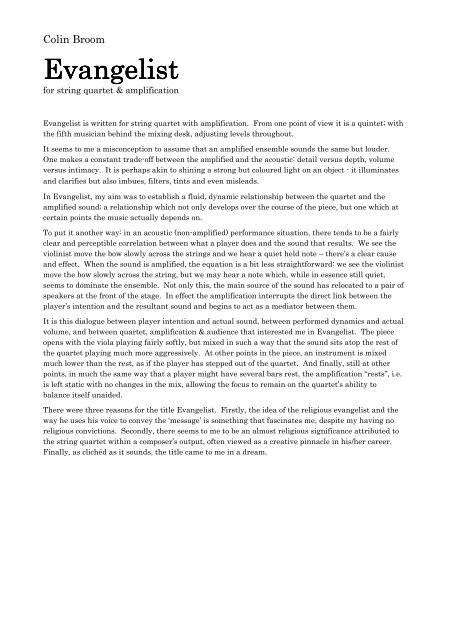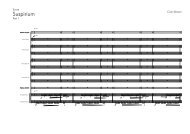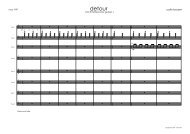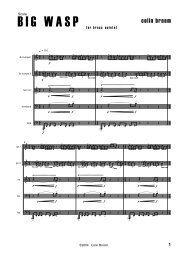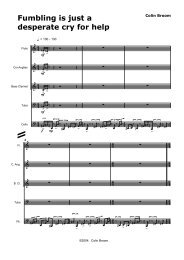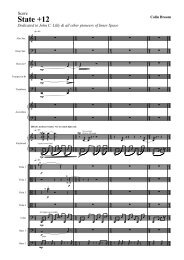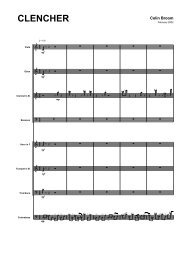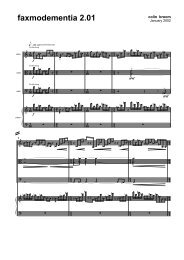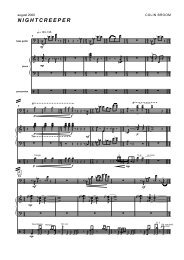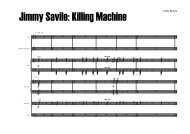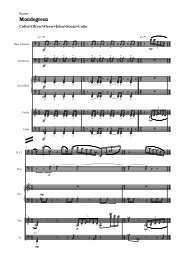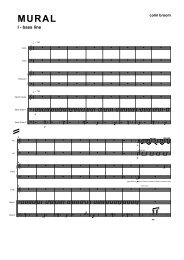Colin Broom - Evangelist
Create successful ePaper yourself
Turn your PDF publications into a flip-book with our unique Google optimized e-Paper software.
<strong>Colin</strong> <strong>Broom</strong><br />
<strong>Evangelist</strong><br />
for string quartet & amplification<br />
<strong>Evangelist</strong> is written for string quartet with amplification. From one point of view it is a quintet; with<br />
the fifth musician behind the mixing desk, adjusting levels throughout.<br />
It seems to me a misconception to assume that an amplified ensemble sounds the same but louder.<br />
One makes a constant trade-off between the amplified and the acoustic: detail versus depth, volume<br />
versus intimacy. It is perhaps akin to shining a strong but coloured light on an object - it illuminates<br />
and clarifies but also imbues, filters, tints and even misleads.<br />
In <strong>Evangelist</strong>, my aim was to establish a fluid, dynamic relationship between the quartet and the<br />
amplified sound; a relationship which not only develops over the course of the piece, but one which at<br />
certain points the music actually depends on.<br />
To put it another way: in an acoustic (non-amplified) performance situation, there tends to be a fairly<br />
clear and perceptible correlation between what a player does and the sound that results. We see the<br />
violinist move the bow slowly across the strings and we hear a quiet held note – there’s a clear cause<br />
and effect. When the sound is amplified, the equation is a bit less straightforward: we see the violinist<br />
move the bow slowly across the string, but we may hear a note which, while in essence still quiet,<br />
seems to dominate the ensemble. Not only this, the main source of the sound has relocated to a pair of<br />
speakers at the front of the stage. In effect the amplification interrupts the direct link between the<br />
player’s intention and the resultant sound and begins to act as a mediator between them.<br />
It is this dialogue between player intention and actual sound, between performed dynamics and actual<br />
volume, and between quartet, amplification & audience that interested me in <strong>Evangelist</strong>. The piece<br />
opens with the viola playing fairly softly, but mixed in such a way that the sound sits atop the rest of<br />
the quartet playing much more aggressively. At other points in the piece, an instrument is mixed<br />
much lower than the rest, as if the player has stepped out of the quartet. And finally, still at other<br />
points, in much the same way that a player might have several bars rest, the amplification “rests”, i.e.<br />
is left static with no changes in the mix, allowing the focus to remain on the quartet’s ability to<br />
balance itself unaided.<br />
There were three reasons for the title <strong>Evangelist</strong>. Firstly, the idea of the religious evangelist and the<br />
way he uses his voice to convey the ‘message’ is something that fascinates me, despite my having no<br />
religious convictions. Secondly, there seems to me to be an almost religious significance attributed to<br />
the string quartet within a composer’s output, often viewed as a creative pinnacle in his/her career.<br />
Finally, as clichéd as it sounds, the title came to me in a dream.


